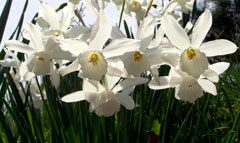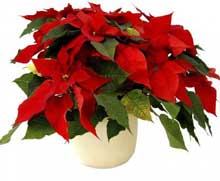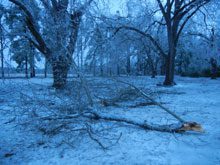 Maybe it started with the damn pear tree in the front yard. One morning the first week of February I looked out and there it was – 35 feet tall and covered with fragrant white blooms. Sure, it was gorgeous; but that full bloom is ridiculous. We always have a hard freeze in February or early March, and this stupid tree thinks it’s making a thousand pears for September picking.
Maybe it started with the damn pear tree in the front yard. One morning the first week of February I looked out and there it was – 35 feet tall and covered with fragrant white blooms. Sure, it was gorgeous; but that full bloom is ridiculous. We always have a hard freeze in February or early March, and this stupid tree thinks it’s making a thousand pears for September picking.
Instead, once the freeze, or the ice storm, or the big snow comes in a couple of weeks, all this blooming will yield nothing at all. At least the two pear trees in the back yard look to be more sensible – not a sign of a bud or bloom yet on them. They will be much more likely to make fruit for our table and for preserving.
It’s what’s been happening all over the yard this winter: precocious blooms appearing because of the particularly warm weather we’ve had. Of course, warm spells have often occurred in our South Carolina winters; usually, however, their effect on the plants is somewhat mitigated by extended periods of cold, often deep cold, and by several good freezes. This tends to remind the plants that it’s not really Spring yet, and they’d be wise to keep from leaping forward with any showy premature springtime display.
Just beside the back steps, all the hydrangeas – which typically are nothing in February but bare stems with brown bud-bumps along them – are showing bright full green leaf growth from those buds. That’s going to turn brown, too, when the freeze comes. Depending on how severe the freeze is, it could kill back all the vital buds; then we’d have only the invisible little adventitious buds beneath the bark, and they won’t produce flowers their first year.
I can go through a litany of things popping out too early: the daylilies, which should be dormant this time of year, have put out luxuriant new leaves, tender and vulnerable; the wonderful native honeysuckle, Lonicera sempervirens, which is bare for the coldest part of winter in most years, has sprouted new leaves and is covered in those brilliant coral trumpets; my adored old rose “Louis Philippe” usually keeps some of its leaves during the winter, but this year it is fully leafed out and has even begun sending out new shoots to be zapped back with any freezing weather.
Moaning and groaning about all this premature growth and bloom, worrying about the inevitable damage that will happen with the big freeze that hasn’t shown up yet, it occurs to me there is a possibility that no hard freeze will come this year. This may be it, the new reality. That suggests other hard truths.
In order to set fruit, peaches and a number of other fruits require a certain number of days with the temperature cold enough to thoroughly chill the trees. The family farm is in a big peach growing area, and there certainly haven’t been enough chilling days this year for the trees to set fruit. If this is the new normal, we may lose the peach farms which have provided employment for generations in the upper coastal plain.
Many perennials and woody plants, shrubs and trees, depend on a winter dormancy for strength and vigor. It gives the plant a chance to rest some of its processes and to build up underground structure and supportive root growth for the intensity of the growing season. With no chance fully to rest during the cold season, some of these shrubs, trees, and plants – including native plants, by the way – will gradually weaken. It may take years for them to die, but a warming climate can do that.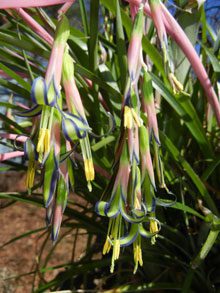
On the other hand, warmer winters might make it possible to grow some plants which would now need protection to get through the winter. I grow the tropical bromeliad, Billbergia nutans, in pots, and I bring them inside for the winter. One year, however, a pot left outside survived perfectly well and has grown to a large size since. They’re one of those things that could become a garden plant in a warmer winter.
Even some of the tropical orchids would be able to survive outdoors with a modest winter rise in temperature, especially if freezes became a thing of the past. My Nun’s Orchid, Phaius tankervilliae, froze to the ground in a freak ice storm one year, and it came back from the dead and bloomed for the first time the following summer. It’s a big plant now – too big for its big pot – so I’d kind of welcome a chance to 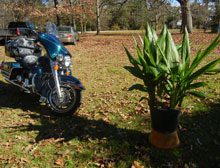 plant it in the garden and leave it. I don’t think, however, I trust that our winters are so consistently warm yet that I would risk losing that treasure.
plant it in the garden and leave it. I don’t think, however, I trust that our winters are so consistently warm yet that I would risk losing that treasure.
I guess climate warming is blaring its arrival. There will be marked changes in how plants (and animals; and humans!) behave in the new normal, and we will have to adapt along with them for as long as the planet stays habitable. I’ll regret not having fresh local peaches, just as a sudden freeze now will make me regret not having fresh pears from the yard. Those may be small sacrifices, however, compared to the massive changes global climate warming offers. For that, all living things will be in a hurry to adapt, escape, or succumb.

